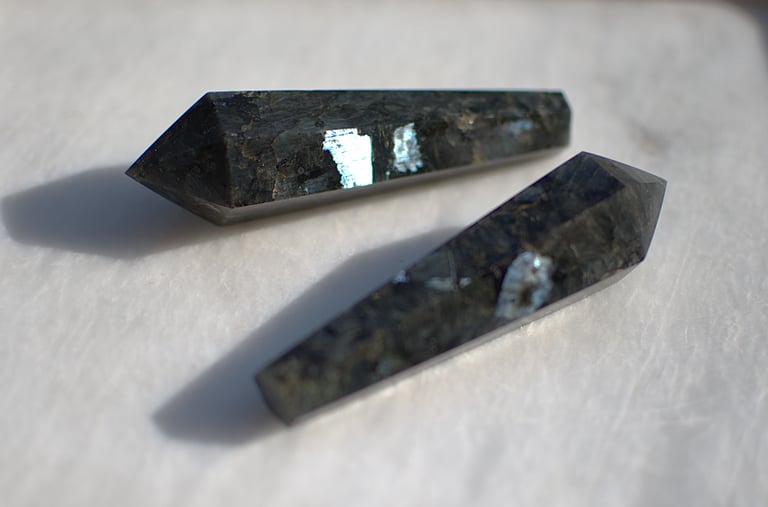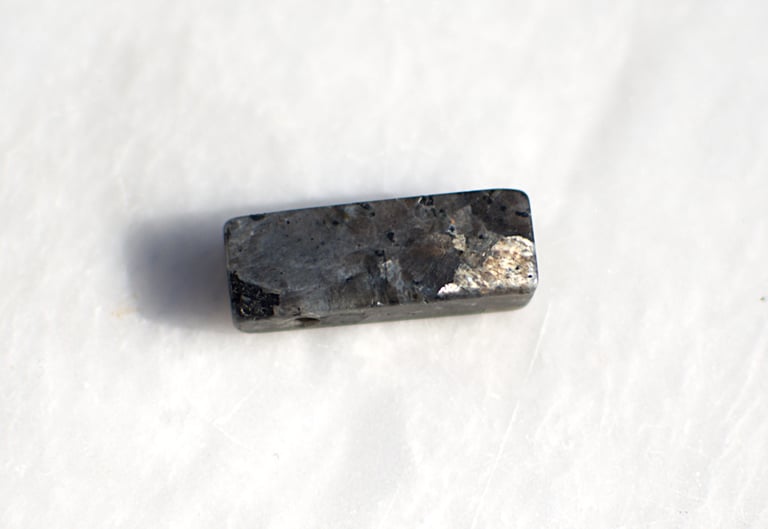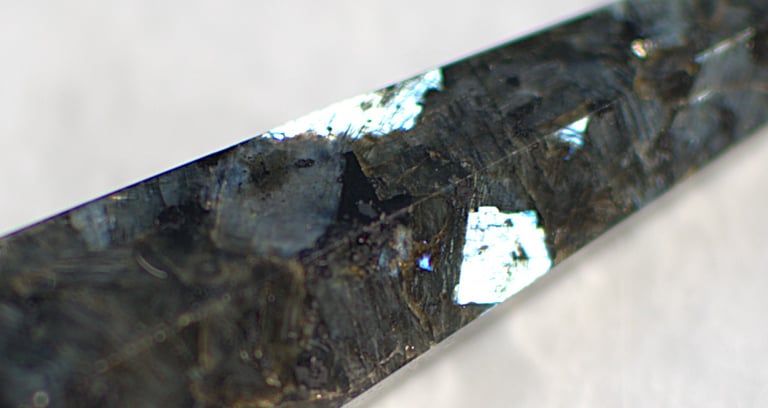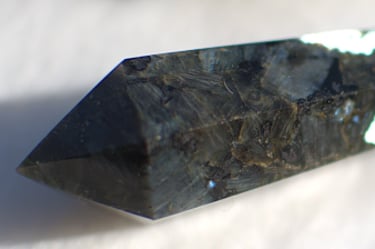Larvikite
Grounding, Protection, Psychic Clarity, Ancestral Connection, Earth Energy, Mental Discipline, EMF Protection
Metaphysical Properties:
A grounding and protective stone that strengthens connection to the Earth and ancestors. It sharpens mental focus, clears energetic blockages, supports psychic clarity, deflects negative energies, and removes illusions. Also used for transformation, shadow work, or spiritual journeying. This stone encourages introspection, promotes discipline, and aids in the integration of wisdom from past lives and ancestral lines.
Symbolism & Associations:
Larvikite is symbolic of patience, ancestral strength, and inner transformation. Often associated with the deep, grounding forces of the Earth, it connects to ancient wisdom and resilience.
Chakra Alignment:
Larvikite primarily resonates with the Root Chakra, anchoring one’s energy and fostering stability.
Planets:
Earth, Saturn
Zodiacs:
Aquarius, Capricorn
Elements:
Earth, Water
Similar Stones:
Labradorite, Nuummite, Moonstone, Indigo Gabbro, Obsidian
Correspondences:
Colours: Charcoal grey, black, silver, blue
Crystals: Black Tourmaline, Hematite, Obsidian, Labradorite
Flowers: Cypress, Mugwort
Herbs: Sage, Vervain
Essential Oils: Patchouli, Myrrh
Incense: Sandalwood, Dragon’s Blood
Metals: Lead, Silver
Months, Days & Seasons: January, Saturday, Winter




Facts
Stone Type:
Feldspar (Monzonite variety)
Hardness Rating:
6–6.5 on the Mohs scale – suitable for occasional wear with some care to prevent scratching.
Chemical Formula:
(Na,Ca)AlSi3O8
Care Guide
Larvikite is moderately durable but should be kept away from prolonged water exposure and abrasive materials. Clean with a soft, dry cloth and store separately.
Spiritual
Larvikite is used to enhance psychic abilities, protect against negative energies, and facilitate ancestral communication. It is also prized for grounding during ritual work or intense spiritual sessions.
Healing
Believed to aid the brain, nervous system, and support recovery from fatigue. Some use it for detoxification and enhancing cognitive function.
Cleansing
Cleanse with smoke (sage or myrrh), place on a slab of Selenite, or leave under moonlight. Avoid water-based cleansing for prolonged periods.
Affirmations
“I am grounded and safe in the present moment.”
“I welcome wisdom from my ancestors.”
“My intuition is clear and focused.”
“I am shielded from all negativity.”
Meditation
Use Larvikite in meditation for journeying to ancestral realms, or to ground after astral travel. Visualising roots extending deep into the earth while holding it enhances its stabilising effects.
Astrology
Favoured by Saturn and Earth signs, Larvikite supports discipline, endurance, and thoughtful action. It is often chosen during retrograde periods for grounding and insight.
Vibration
Larvikite emits a steady, anchoring vibration that deepens one’s connection to the Earth. It is subtly intense, helping quiet mental chatter and promote clarity.
Did You Know:
Larvikite is Norway’s national stone and is used architecturally around the world—including in the United Nations Headquarters in New York.


Mythology & Folklore
Larvikite, though not an ancient stone in terms of documented use, carries an aura of ancestral wisdom deeply tied to the lands from which it is mined—primarily Norway. As a stone formed in the depths of the Earth over 300 million years ago, it evokes powerful themes of deep time, endurance, and the primal roots of existence. In modern Norse-inspired spiritual practices, Larvikite is sometimes linked with the ancient jotnar (giants) of Norse mythology—primordial beings representing raw elemental power and nature’s untamed forces. The stone’s dark, stormy base and sudden silver-blue flashes are reminiscent of deep fjords lit by moonlight or the eyes of ancient, watching spirits.
Some spiritual practitioners associate Larvikite with the Allfather Odin, especially his aspect as the seeker of hidden knowledge and runes. Just as Odin gave up his eye to see beyond the veil, Larvikite is thought to help those delving into hidden truths, ancestral work, and subconscious realms. Folklore passed down in Scandinavian regions sometimes refers to “moon rocks” found in the highland soils—likely referencing the feldspar-rich Larvikite—as being stones that “see what humans cannot.” This supports its metaphysical reputation as a psychic shield and seer’s companion.
In some circles, Larvikite is considered a “waking dream” stone—one that doesn’t transport the user away from reality, but instead reveals the deeper truths within it. This balance of grounded awareness and intuitive insight mirrors tales of wise elders, shamanic seers, and forest witches in Nordic traditions who worked with land spirits, runes, and dreams to guide their communities.
In Scandinavian folklore, stones with a deep, mysterious shimmer are sometimes believed to be gifts from the gods. For Larvikite, the shimmering effect is thought to be a reflection of the Northern Lights, the Aurora Borealis, which is an essential feature of the Scandinavian landscape. The stone's flashes of blue are often likened to the vibrant and fleeting colours in the sky as the Northern Lights swirl across the night, tying the stone to both the celestial and terrestrial worlds.
Norwegian myths also regularly feature stories of trolls, giants, and mythical creatures that live beneath the earth, deep in caves and mountains. Larvikite, with its otherworldly glow, is sometimes said to hold the ancient wisdom of these underground beings. The flashes of silver and blue are believed to be the hidden knowledge these creatures guard. Some legends suggest that Larvikite stones were used by shamans and wise women to communicate with the spirits of the earth, serving as a link to the unseen world and as a tool for spiritual awakening.
Historical Significance
Larvikite, named after the region of Larvik in Norway, where it was first discovered, has been used in various ways throughout history, although its use and recognition have been more recent compared to other minerals like quartz or agate. The stone is a variety of feldspar, and while it may not have been used in ancient rituals as extensively as other stones, its significance is growing in the modern metaphysical world.
In historical architecture, Larvikite has been employed as a decorative stone. Its shimmering qualities make it a popular choice for kitchen work surfaces, floors, and even as an ornamental stone for buildings. In the 20th century, when granite became a common building material, Larvikite's striking appearance caught the attention of architects and designers, leading to its inclusion in high-end construction projects. The stone has been used for everything from statues to exterior facades, enhancing buildings with its deep, mysterious beauty.
Beyond architecture, Larvikite has been tied to the traditions of Scandinavia, where it is considered a part of the natural heritage. While it might not have been considered sacred in ancient rituals to the extent of amethyst or obsidian, it still represents the powerful and enduring force of the land itself. Its links to volcanic activity and the geology of the region have made it a symbol of the earth’s strength, resilience, and creativity.
Origin & Formation
Larvikite, a member of the feldspar family, is a striking stone with a deep blue-grey to almost black base colour, often with silvery or bluish flashes that make it appear iridescent. This flash, also known as “labradorescence,” is what gives Larvikite its distinctive, shimmering appearance, although it is not technically the same as the rainbow flashes of Labradorite. The flashes are caused by the stone’s internal structure, which diffracts light in particular ways due to the unique arrangement of its mineral components.
The stone gets its name from the Larvik region in Norway, where it was first discovered. Larvikite is an essential part of the region’s geological makeup, formed through volcanic processes that occurred millions of years ago. The mineral forms from the cooling and crystallization of magma deep within the Earth, often in areas with significant tectonic activity. This stone is found primarily in Norway, but it has also been located in other regions with similar geological conditions, such as parts of the United States and Canada.
The feldspar family of minerals, to which Larvikite belongs, is known for its use in various industries, including the manufacturing of glass and ceramics. However, Larvikite stands out from other feldspars due to its unique colouration and the phenomenon of labradorescence. The volcanic activity in the Larvik region provided the perfect conditions for the formation of this stone, with its rich mineral composition and high-quality crystallization process contributing to its high value in the market today.
The flash of blue and silver within the black base is caused by the way light interacts with the minerals in the stone. As light passes through the surface of Larvikite, it is bent and reflected by microscopic layers of minerals inside the stone, creating the distinctive, shimmering effect. While Larvikite is often confused with Labradorite, it has its own unique geological formation and structure that sets it apart.
Variation & Quality
Larvikite is relatively consistent in appearance, with a dark grey to black base and flashes of blue or silver throughout. However, the intensity of the labradorescence can vary depending on the quality and size of the stone. Some pieces exhibit a more pronounced, multicoloured flash, while others may show only faint blue or silver highlights. Faceted stones may show less flash due to the cut of the stone, with raw specimens showing the most flash.
The quality of Larvikite is often determined by the size and consistency of the labradorescence. High-quality Larvikite stones will have an intense flash of blue or silver across the stone, while lower-quality or faceted pieces may have only very small flashes. In general, the larger the stone, the more noticeable and intense the flash will be.
Larvikite is generally cut into cabochons, beads, and polished stones for use in jewellery, as well as into slabs for architectural use. The flashes in the stone can create dramatic effects when the light hits them at the right angle, making it a sought-after stone for decorative purposes. Larvikite is one of our favourites here at The Natural Life, due to the intense silver flashes being so eye-catching when worn in jewellery. Some jewellers also use Larvikite in combination with other stones, such as Labradorite, to create pieces that feature complementary colours and energies.
While Larvikite is in some areas considered to be a more affordable alternative to Labradorite, it still shares many of the same metaphysical properties, including protection, grounding, and spiritual insight. Its consistent appearance and striking flash make it a popular choice for jewellery designers, as well as for collectors of unique and rare stones.
Notes
Larvikite is popular in both metaphysical and design circles. It’s a favourite for kitchen work surfaces, tiles, and jewellery settings where grounding energy and elegance are both desired. Though sometimes sold under the name Black Moonstone or even misleadingly as Labradorite, Larvikite is a distinct stone with unique properties. In energy work, it’s ideal for shielding and mental clarity. It also pairs well with Selenite for clearing residual energy after ancestral meditations. Because of its quiet power, it’s often chosen by those who work in healing professions or intense emotional environments. It’s said to help protect against EMFs when kept near electronics.






